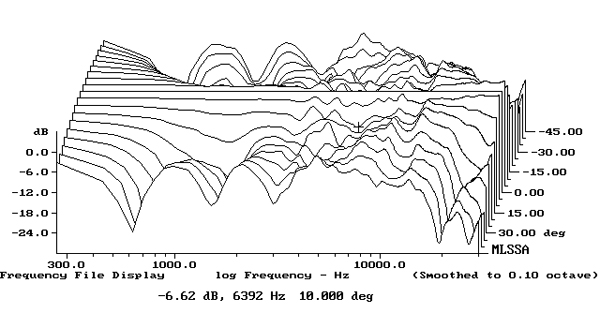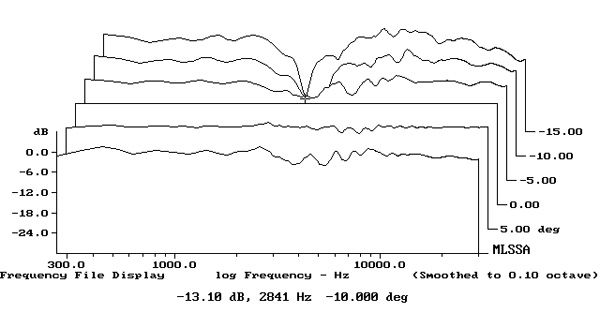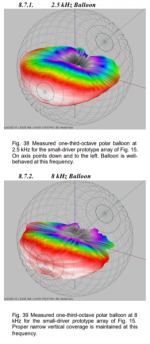Allen B : As Juhazi points out, it's' the vertical plot that reminds me of Dr. D'Appolito moving to use higher order filters and the rational behind his choices.
That's pretty awful, but from a practical perspective, owners have been quite happy with it and haven't noticed.
That's pretty awful, but from a practical perspective, owners have been quite happy with it and haven't noticed.
I read the comment: ["The closer I sat to the speakers, the less focused the aural images were;"]. This leads me to believe that either the baffle edge contribution, or the vertical polar response (fig.5) is troublesome.
Then I read this: ["Getting the Impact Monitors to focus their best required placing them closer together than I ever could have imagined would work—the centers of their central tweeters were only 5.6' apart"]...
So I was inclined to question the horizontal smoothness. On the polar there is a flawed region between 3k and 6kHz. Could be Patrick is right in suggesting a lobing issue?
The answer to your question is in the CBT curve from Monte Kay that I posted in message #18.
In particular, notice how the top three curves are virtually the same.
This means that if you're within a beamwidth of about sixty degrees (+/- 30 degrees) the sound of the speaker doesn't change.
This can lead to some really peculiar setups. You can put the speakers really close together or really far apart and the sound simply doesn't change a whole lot.
Keele has posted some measurements that show that the SPL level of a CBT barely changes as you move forward or backwards.
It's really eerie, because 99% of us have never heard a speaker that behaves like this.
Here's one way to think about it:
Imagine if you're at a rock concert, and you're two hundred feet from the stage. If you move ten feet, does the sound change very much? No, it doesn't. Because the speakers are 200' away.
A CBT approximates a point source which is much further away.
For instance, Jim Griffin's CBT approximates a point source that's about three feet *behind* that back wall. The apparent source of sound is the apex of the arc that forms the CBT. The sound doesn't sound like it's coming from the loudspeaker; it sounds like it's coming from a point somewhere *behind* the speaker, but the source is hazy.
I think that one of the reasons that CBTs sound a bit hazy is because they're illuminating the room with a hundred reflections from dozens of drivers. So our brains don't have a way of processing that. We're accustomed to loudspeakers that sound like they're radiating from a single point in space.
For an audio reviewer, this can be a bizarre experience; it's difficult to 'dial in' a speaker when moving it around the room doesn't change things much.
And, again, people are probably wondering why I'm talking about CBTs in a thread about the Tekton Impact. But the tweeter array is largely a two-dimensional CBT array.
Last edited:
Hi Patrick,
Forgive my ignorance, but you posted a great deal which I feel like playing devil's advocate to. Please illuminate the areas where I lack enough understanding.
Not sure how this is different than my current two way, except for the lack of haze. I mean, ideally, I want the speakers to disappear and transmit the recording, not the speaker and it's location. I don't hear the acoustic center of my speakers. I hear a deep soundstage.
That's called dispersion! But it also sounds like you are saying : "The drivers don't integrate well enough to become a single planar wavefront."
So it is independent of room boundaries? Sounds great to me!
Best,
Erik
Forgive my ignorance, but you posted a great deal which I feel like playing devil's advocate to. Please illuminate the areas where I lack enough understanding.
For instance, Jim Griffin's CBT approximates a point source that's about three feet *behind* that back wall.
Not sure how this is different than my current two way, except for the lack of haze. I mean, ideally, I want the speakers to disappear and transmit the recording, not the speaker and it's location. I don't hear the acoustic center of my speakers. I hear a deep soundstage.
illuminating the room with a hundred reflections from dozens of drivers.
That's called dispersion! But it also sounds like you are saying : "The drivers don't integrate well enough to become a single planar wavefront."
moving it around the room doesn't change things much.
So it is independent of room boundaries? Sounds great to me!
Best,
Erik
I think that one of the reasons that CBTs sound a bit hazy is because they're illuminating the room with a hundred reflections from dozens of drivers. So our brains don't have a way of processing that. We're accustomed to loudspeakers that sound like they're radiating from a single point in space.
I don't believe in this analysis... think again, each driver has it's reflections at slightly different positions than the next. That's why it is less placement dependent, as long as it has a little room to breathe.
Bringing back the focus shouldn't be too hard. Making it sound just like a point source, but better behaved inside the room. Check out some in room measurements of a CBT, I believe Omholt has shown us a few.
Hate to post on a thread on the Tekton tweeter array but I want to relate my thoughts on how my Modified CBT24 sound in my listening room. I describe my speakers in my thread at:
My New Line Array--It's a Modified CBT24
I disagree with Patrick that a CBT sounds 'hazy' or at least my speakers don't exhibit such sound. In my room vocals and instruments sound clear and are correctly placed across the soundstage. My CBT functions on a ground plane so any floor reflections are mirrored so they are correctly placed in time by the floor which doubles the inherent size of the array. The shading of the array as it extends upward diminishes any sound which might reflect from the room ceiling. Furthermore, in my room the speakers are spaced so that side walls are 10-12 feet away from them. Thus any side reflections would have to travel at least double those distances to impact a listener. Thus the distances involved to the ceiling and sides reduce extraneous sounds and thus mitigate any reflected sounds heard by a listener within the room.
Again this confirms Don Keele's comments about the coverage of a CBT. He states that CBTs exhibit constant beamwidth, constant directivity, constant coverage, and near constant radiated power within the room. I'm hearing the same sound in my listening room with my CBTs. A CBT creates a 'sweet room' effect versus just a 'sweet spot'.
CBTs also do not suffer from combing effects. You can move your ears up and down a line of speakers and hear consistent sound no matter your distance to the array.
My New Line Array--It's a Modified CBT24
I disagree with Patrick that a CBT sounds 'hazy' or at least my speakers don't exhibit such sound. In my room vocals and instruments sound clear and are correctly placed across the soundstage. My CBT functions on a ground plane so any floor reflections are mirrored so they are correctly placed in time by the floor which doubles the inherent size of the array. The shading of the array as it extends upward diminishes any sound which might reflect from the room ceiling. Furthermore, in my room the speakers are spaced so that side walls are 10-12 feet away from them. Thus any side reflections would have to travel at least double those distances to impact a listener. Thus the distances involved to the ceiling and sides reduce extraneous sounds and thus mitigate any reflected sounds heard by a listener within the room.
Again this confirms Don Keele's comments about the coverage of a CBT. He states that CBTs exhibit constant beamwidth, constant directivity, constant coverage, and near constant radiated power within the room. I'm hearing the same sound in my listening room with my CBTs. A CBT creates a 'sweet room' effect versus just a 'sweet spot'.
CBTs also do not suffer from combing effects. You can move your ears up and down a line of speakers and hear consistent sound no matter your distance to the array.
Last edited:
Hi Patrick,
Forgive my ignorance, but you posted a great deal which I feel like playing devil's advocate to. Please illuminate the areas where I lack enough understanding.
Not sure how this is different than my current two way, except for the lack of haze. I mean, ideally, I want the speakers to disappear and transmit the recording, not the speaker and it's location. I don't hear the acoustic center of my speakers. I hear a deep soundstage.
That's called dispersion! But it also sounds like you are saying : "The drivers don't integrate well enough to become a single planar wavefront."
So it is independent of room boundaries? Sounds great to me!
Best,
Erik
Let me clarify some of my comments on CBTs sounding "hazy."
An externally hosted image should be here but it was not working when we last tested it.
Conventional loudspeakers look like this. The left speaker, right speaker and the listener form a triangle. The loudspeakers are equidistant to the listener.
Because the loudspeakers are equidistant, the depth of the soundstage is generally defined by the distance to the loudspeaker.
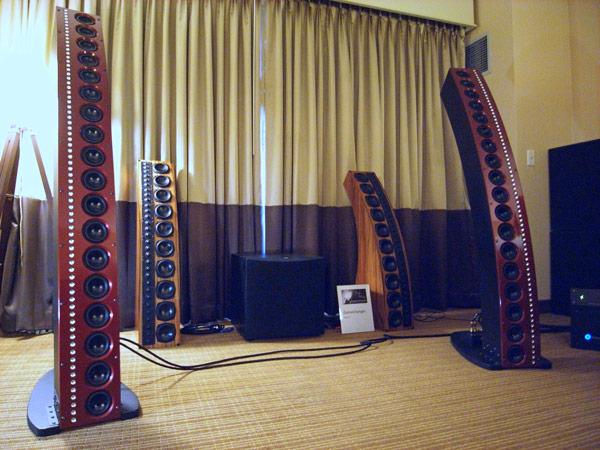
In a CBT, the pathlength to the drivers varies quite a bit. I've heard the CBT24 and the CBT36, and the depth of the soundstage was nebulous.
The top of the CBT24 is nearly two feet deeper than the BOTTOM of the CBT24. I believe that this variance in depth is audible; when listening to the CBT, the depth of the stage isn't apparent.
Three years ago I rented some SH50s and listened to them in my tiny condo in San Diego. They exhibit the same behavior; basically it's really difficult to tell where the sound is coming from.
I've told this story a million times, but here goes again:
While renting the SH50, our thirteen year old daughter literally asked me which speaker was playing. And this was while she was sitting one foot away from the SH50s. I think that's wild; she was literally getting blasted by a SH50 playing 100dB+, and she couldn't even tell if it was on. Try doing THAT with a conventional speaker.
Again, I think the key to this is that the DEPTH of the drivers is varied. (In the CBT 24, the top of the loudspeaker is nearly two feet further back than the bottom. In the SH50, the woofers are about one foot closer than the tweeter.)
It's a neat trick I think. It's eerie. When listening to music, it was bizarre how the HORIZONTAL positions were pinpoint, but the DEPTH of the soundstage was nebulous.
If things were reversed, it would be VERY BAD. For instance, imagine a loudspeaker where the HORIZONTAL locations are nebulous, and the DEPTH of the soundstage is pinpoint? You wouldn't want that, it would sound terrible.
Wouldn't an equivalent waveguide (at the same apparent apex) do the same? One of the functions of the shading is to manage diffraction. In the case of this wavefront the sound traveling over your head will continue that way with diffraction normal to it.The top of the CBT24 is nearly two feet deeper than the BOTTOM of the CBT24. I believe that this variance in depth is audible;
I find that a single driver waveguide will do this.she was literally getting blasted by a SH50 playing 100dB+, and she couldn't even tell if it was on. Try doing THAT with a conventional speaker.
What I'm not getting is the very large discrepancy between the CBT design goals and Patrick's position.
The goal of the CBT is a single unified wavefront, but Patrick seems to feel this does not happen, and there is instead many little ones.
An impulse response would be really interesting at this point.
The goal of the CBT is a single unified wavefront, but Patrick seems to feel this does not happen, and there is instead many little ones.
An impulse response would be really interesting at this point.
What I'm not getting is the very large discrepancy between the CBT design goals and Patrick's position.
The goal of the CBT is a single unified wavefront, but Patrick seems to feel this does not happen, and there is instead many little ones.
An impulse response would be really interesting at this point.
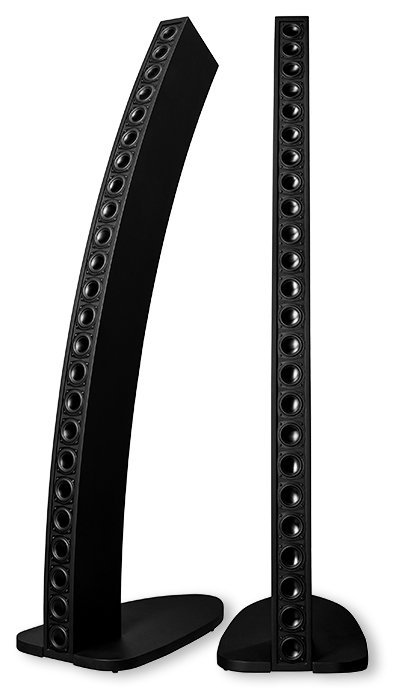
The CBT loudspeakers control directivity in one axis: the Y axis.
Horns like the SH50 control directivity in two dimensions : horizontally and vertically.
Basically, the wavefront of the CBT is uncontrolled in the horizontal axis. I'm not trashing the CBT at all; I think that wide horizontal directivity is A Good Thing. But the CBT and the SH50 sound noticeably different. I believe a big part of this is that the SH50 has a beamwidth that's consistent in the horizontal and vertical axis. The CBT only has narrow beamwidth in the vertical axis. It would be possible to make a two-dimensional CBT, but no has tried it... unless you consider the Tekton array to be a CBT.
It's on Don Keele's home page. I'm surprised more people haven't done this.It would be possible to make a two-dimensional CBT, but no has tried it...
This research describes a curved-surface transducer in the form of a spherical cap
Keele has not constructed or at least not published a speaker with a cross of circularline arrays. In the papers available on his site, all are just vertical arrays and he has studied their lateral and vertical dispersion. It is controversial if a 180¤ wide lateral radiation is good in a room.
Seems like most people forget, that studies and first implementations were for Pa, auditoriums and arenas etc. large spaces.
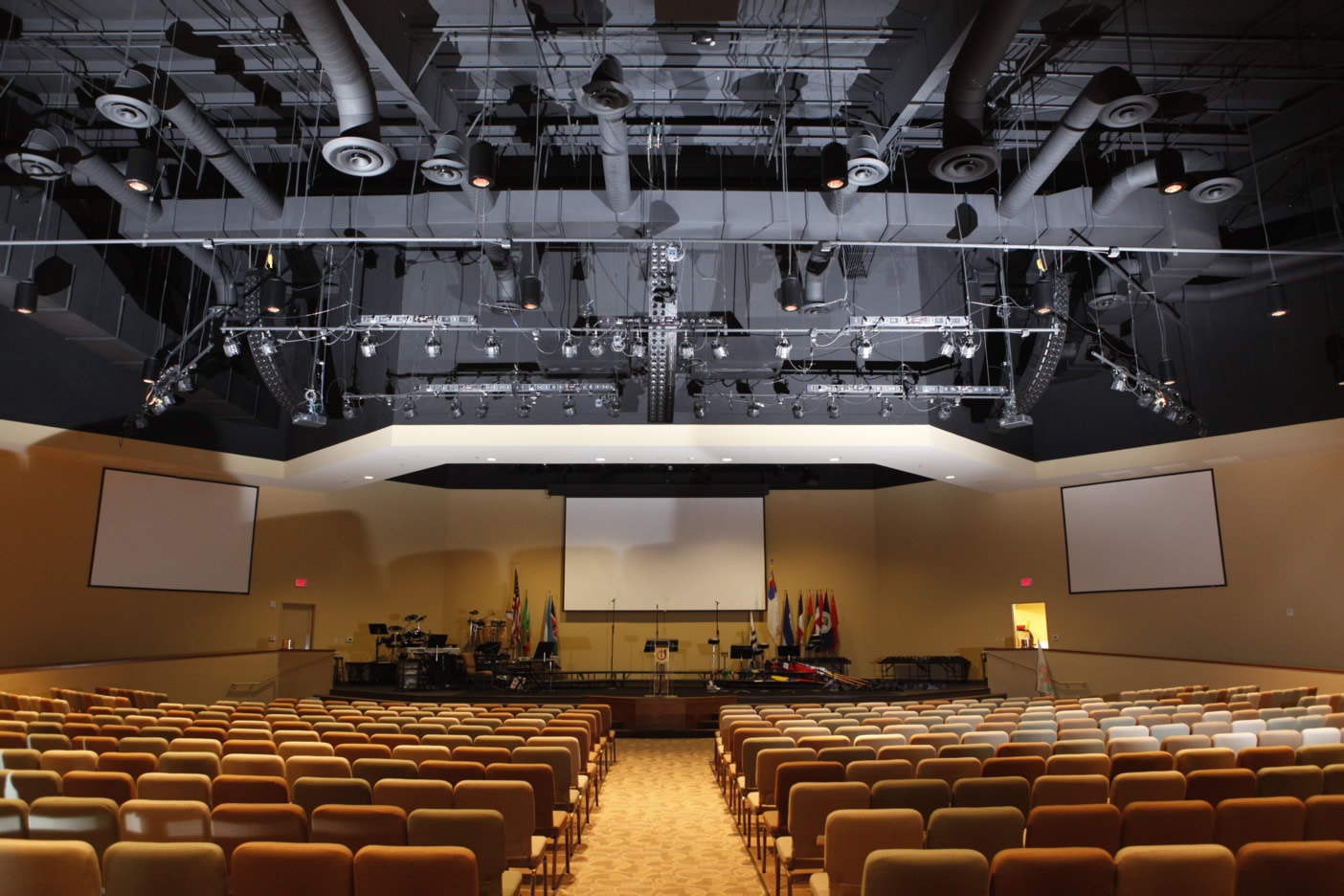
Real-world measurements however tell that lateral response is not symmetrical if mid and tweeter lines have separation. This is from paper #4, proto with small fullrange drivers
Seems like most people forget, that studies and first implementations were for Pa, auditoriums and arenas etc. large spaces.

Real-world measurements however tell that lateral response is not symmetrical if mid and tweeter lines have separation. This is from paper #4, proto with small fullrange drivers
Attachments
Last edited:
I think that one of the reasons that CBTs sound a bit hazy is because they're illuminating the room with a hundred reflections from dozens of drivers. So our brains don't have a way of processing that. We're accustomed to loudspeakers that sound like they're radiating from a single point in space.
The CBT does not have multiple reflections from each driver at least not in the way being described here. Each driver is working to form a well formed wavefront and it is this wavefront that we hear (or measure) and discuss about. If the array is throwing x spl at a location then its due to the sum of all drivers, what extra information do we need to draw by individual reflections, nothing. Trying to explain the CBT by multiple reflections is going to cause only confusion and is redundant. The CBT is emulating a point source. The difference is:horizontally the 2 way has weird directivity whereas the CBT is wide directivity and hence different signatures
The hazyness is due to wide horizontal directivity, its an omni horizontally.
Last edited:
Though this is a Tekton thread, let me mention another way of achieving directivity. I think a big dome (pistonic) could also work to give good directivity.
Why is it so?
CBT theory has 2 conditions for directivity, delay and shading. And it also shows that shading is less important than delay. Now, a dome has both, delay due to curvature and shading again due to curvature. The center of the dome produces more spl due to it vibrating perpendicular to dome central axis and the sides being at an angle produce lower spl for the same dome travel, so we see that a dome has inherent shading when we go from center to the edge and observe constant surface area travel
So, if we focus on delay (by controlling curvature) since thats more important than shading and leave the shading to be whatever the dome gives inherently then we have a fullrange driver that give constant directivity to a very low frequency.
Isnt a big dome a spherical CBT? Quite close.
Time somebody made a 3" or 5" dome fullrange.
Note:-We have no waveguide or horn here so the fact that domes make a bad match for waveguide/horn loading does not figure here.
Why is it so?
CBT theory has 2 conditions for directivity, delay and shading. And it also shows that shading is less important than delay. Now, a dome has both, delay due to curvature and shading again due to curvature. The center of the dome produces more spl due to it vibrating perpendicular to dome central axis and the sides being at an angle produce lower spl for the same dome travel, so we see that a dome has inherent shading when we go from center to the edge and observe constant surface area travel
So, if we focus on delay (by controlling curvature) since thats more important than shading and leave the shading to be whatever the dome gives inherently then we have a fullrange driver that give constant directivity to a very low frequency.
Isnt a big dome a spherical CBT? Quite close.
Time somebody made a 3" or 5" dome fullrange.
Note:-We have no waveguide or horn here so the fact that domes make a bad match for waveguide/horn loading does not figure here.
Last edited:
There are some 2-3" diameter cone drivers, but they work only as midrange.
The dome shape gives nice dispersion, but also less volume displacement to produce significant spl below 300Hz. The dome also has to be quite rigid - heavy so high end efficiency is lost too.
The most respected large dome is ATC 75mm dome, which is no longer available for diy. It's clone is Volt 75mm dome but it has even more problems.
Both are discussed in may threads here, but this is a very deep test of the ATC
http://studio-hifi.com/images/ATC75-150S_JeffBagby.pdf
and discussion here Full Review of ATC SM75-150S Midrange Driver -
Techtalk Speaker Building, Audio, Video Discussion Forum
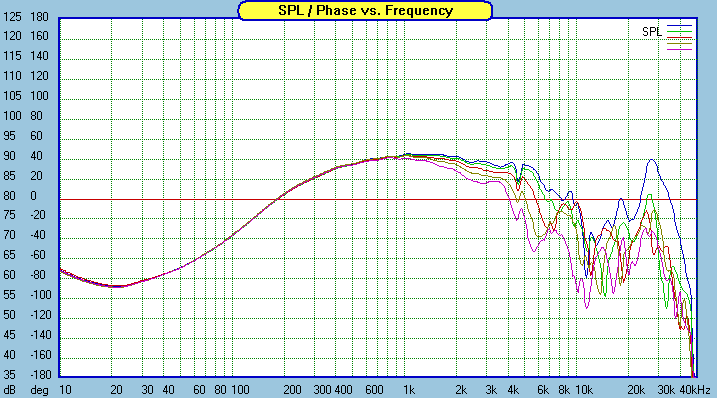
The dome shape gives nice dispersion, but also less volume displacement to produce significant spl below 300Hz. The dome also has to be quite rigid - heavy so high end efficiency is lost too.
The most respected large dome is ATC 75mm dome, which is no longer available for diy. It's clone is Volt 75mm dome but it has even more problems.
Both are discussed in may threads here, but this is a very deep test of the ATC
http://studio-hifi.com/images/ATC75-150S_JeffBagby.pdf
and discussion here Full Review of ATC SM75-150S Midrange Driver -
Techtalk Speaker Building, Audio, Video Discussion Forum

Last edited:
300Hz is not bad , a helper woofer is a given for the 'fullrange' being discussed. The dome certainly can be made rigid, most of the domes diaphragms are made using curved flat surface, now, if they are corrugated then they can easily surpass 20khz pistonic criteria. Some large format compression drivers already have been using 'embossed' pattern to avoid breakup. High end efficiency is not a concern coz the CBT also has a falling response in the highs even though it uses drivers with good highs. Eq can bring the highs back.The dome shape gives nice dispersion, but also less volume displacement to produce significant spl below 300Hz. The dome also has to be quite rigid - heavy so high end efficiency is lost too.
They arent pistonic enough.The most respected large dome is ATC 75mm dome, which is no longer available for diy. It's clone is Volt 75mm dome but it has even more problems.
- Home
- Loudspeakers
- Multi-Way
- Help Understanding Tekton Tweeter Array Schematic?
